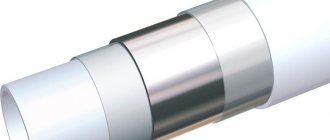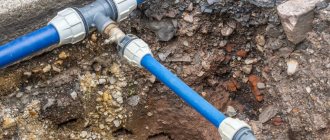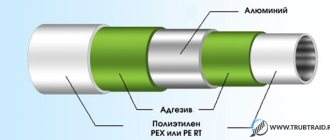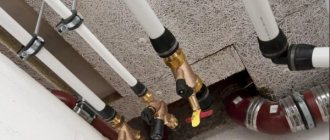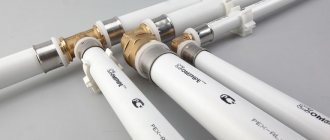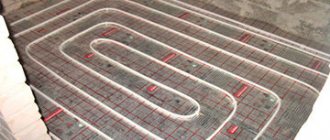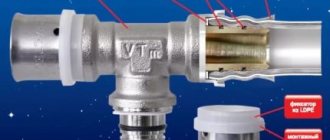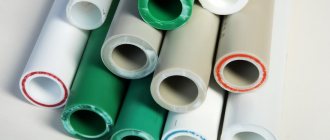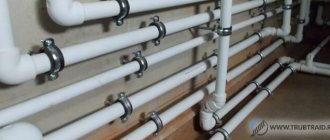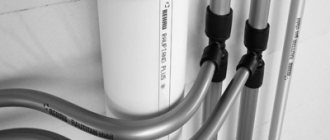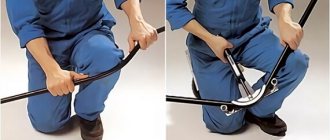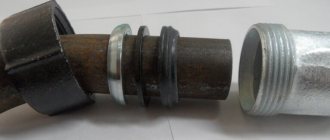A water supply system made of metal-plastic pipes includes connecting elements called fittings.
Connecting elements
What types of compression fittings are there for metal-plastic pipes? How to install them correctly? What to do if the connection starts to leak? You will find out the answers to these questions by reading the article.
Types, purpose, prices
Compression fittings are used for:
- Connections of water pipes of the same and different diameters.
- Pipeline branches.
- Installation of additional equipment (filters, flasks, etc.)
- Changes in the direction of the water supply.
- Connections of a metal-plastic pipe with a metal or plastic one.
Depending on the purpose, they can be divided into types.
Corner metal
Used to change the direction of the pipeline. Elements with an angle of 90 and 120 degrees are in demand.
Angle metal fitting
In professional slang, corner elements are called bends, so this name is often applied to metal corner fittings for metal-plastic pipes.
The corner element is used to connect water pipes of the same diameter and has a crimp fastening on both sides. There are bends for the metal-plastic system, in which on one side there is a thread, external or internal. Such elements are designed for corner connections with various equipment.
Another variety is water sockets. They have the appearance of an angular one with a crimp fastening on one side and an internal thread on the other. Additionally, they have a platform with holes designed for rigid fixation using self-tapping screws.
Metal tees
Tees are types of fittings for metal-plastic water pipelines, which are used to branch from the main pipe, connect taps or other elements.
Metal tee
*
Depending on the version, it differs in the combination of fastenings. For example, two sides are a crimp fastener of the same diameter, the third is threaded, or vice versa.
For the convenience of customers, the manufacturer marks the tees by pipe or thread size. As an example, consider the designation 20x1/2″x20. This is a tee, because the designation has three numbers, two ends of which are intended for installing a pipe, and the third has a thread. The diameter of the pipe for which the tee is intended is 20 mm, the threaded connection is ½ inch.
Couplings
This type is intended for connecting pipes of the same or different diameters. The outputs have a crimp connection.
coupling
The dimensions of the coupling depend on the diameter for which it is intended. The most common:
- 20x16;
- 20x20;
- 32x16;
- 32x20.
Couplings can be made with internal or external thread on one side. In this case, the marking will look 16x3/4″. The first number is the diameter, the second is the thread size. Couplings with a threaded connection are used when it is necessary to transition from a metal pipeline to a metal-plastic one.
Connecting
*
For a connection between a metal-plastic pipe and a manifold, a special connecting fitting is used.
Connection fitting
Depending on the type of collector, the design may differ. As a rule, the marking of the connecting fitting indicates the letter designation of the type of manifold for which it is intended. For example: EK – means that the element is used for manifolds with Eurocone output.
Crosspieces
Connection element with four outputs. Output fastenings can be crimped or threaded, and can be combined in different ways.
Cross connection
They are mounted like ordinary metal structures, with the exception of cases where one of the outputs has a threaded connection. In such a situation, installation begins with the threaded connection.
Fittings by material
Connecting elements for metal-plastic pipes can be made from various materials. The most common are brass with various coatings. The coating is designed to protect the metal from corrosion and extend the life of the part. On sale you can find:
- Nickel plated brass.
- Brass with tin plated.
- Nickel plated brass with tin coating.
- Brass chrome plated.
Popular options are nickel-plated and chrome-plated brass.
There are also steel and copper ones, but they are less popular. Copper due to high price, steel due to low corrosion resistance and short service life.
Connection with polypropylene and PVC pipes
Metal-plastic pipes are connected to polymer pipes, just like with steel pipes - by means of a threaded connection.
It is impossible to cut threads on PVC or polypropylene pipes, but special combined couplings are produced for them, equipped with this structural element on one side.
After heating with a special soldering iron, the coupling is put on the pipe, which is also heated beforehand. The softened plastic of both parts is fused into a monolithic structure.
Design and principle of operation
*
Structurally, a compression fitting consists of three parts: a base, a clamping nut and a compression ring (cone). The system operates on the collet principle, i.e. in the process of tightening the nut, it presses on the conical ring, which contracts and reliably presses the pipe to the base. It sounds complicated, but in reality everything is much simpler. The base has a seat for a hose of a certain diameter. It has rubber gaskets. The diameter of the seat corresponds to the inner diameter of the hose, the nut has a hole equal to the outer diameter of the pipe.
Assembly order
The fitting is installed on a metal-plastic pipe according to a certain algorithm.
Fitting installation
First, a nut is put on the pipe so that the thread is directed towards the base (joint). Next, the crimp ring is put on. After this, the pipe is put on the seat. The ferrule is moved towards the base of the fitting until it becomes possible to seat the clamping nut onto the thread. At the last stage, using an adjustable wrench, the nut is tightened until it stops.
Important! Over time, the pipe at the fitting installation site may begin to leak; to eliminate the leak, the fitting must be tightened.
Features of installing a threaded fitting
To connect a metal pipe to a metal-plastic pipe at an angle, a brass fitting with a threaded connection on one side is used. When installing such a fitting, there is a feature that must be taken into account. It is necessary to begin the installation by installing the threaded connection, because otherwise, the connection will not be established.
It is worth considering that the threaded connection is not always airtight; to prevent leakage, it is better to use sealants or fume tape.
Another nuance that must be taken into account when installing a fitting is the quality of the edge (installation location) of the pipe. The end must be cut straight, not bent or stretched.
How to connect metal-plastic pipes with metal ones
To connect metal-plastic pipelines to metal ones, fittings with internal threads are used.
In this case, an external thread must be cut at the end of the metal pipe.
Installation of the connection begins by screwing the fitting onto a metal pipe.
The part must fit tightly onto the thread, for which plumbing flax, tow or fluoroplastic sealant (FUM tape) is placed in its grooves. Not everyone can guess the amount of sealant the first time. Please note that an overdose is fraught with more unpleasant consequences than an underdose, since the fitting in this case may burst. If there is a lack of sealant, a leak will simply occur, to eliminate which the connection will have to be redone.
Inexperienced home craftsmen can simplify the task of making pipe threaded connections by using Tangit Unilok sealing thread. When laying it, you won’t have to guess about the required quantity. If a small overload does occur, the screwed-on part will still remain intact.
Advantages and disadvantages of metal crimp connections
*
Compared to other types of connections, crimp structures have several advantages, the main one being the possibility of reuse. Due to the fact that the design has a threaded connection and a pressure ring, the fitting can be mounted and dismantled almost endlessly.
The main malfunction that can occur due to frequent re-installation is rupture of the sealing rubber. This can be easily fixed by installing a new rubber band from a repair kit, which is sold everywhere.
Repair kit
The advantages include high speed of connection assembly and the possibility of combination. Using metal fittings, you can easily extend a pipe or repair a broken pipe.
The disadvantage of metal fittings is that they are susceptible to corrosion. Over time, the connection rusts, rots, and may begin to leak. In some cases, tightening the connection nuts will not help eliminate the leak; the fitting will have to be replaced.
Another disadvantage of metal compounds is condensation that accumulates on the surface. When installed in a cold water supply system in conditions of insufficient ventilation, condensation constantly accumulates on the surface, which can drain and accumulate in one place. This phenomenon can lead to a number of negative consequences that can be avoided by using other types of connections.
Pros and cons of metal-plastic products
Metal-plastic has characteristics that make it possible to create reliable systems with a service life of 15 to 50 years. The outer diameter of the products is 16-63 mm. The fittings must fully match the diameter of the pipes, while the wall thickness (2-3 mm) must also be taken into account.
For internal wiring, the most optimal diameter is 32 mm. Water is supplied to heating devices most often through narrower products - from 22 mm to 24 mm.
The joining of two metal-plastic pipes occurs through fittings, which also have different diameters, differ in installation method, purpose and configuration. Material of manufacture – stainless steel and brass
Metal-plastic pipelines can withstand temperatures up to +95ºС (with interval increases up to +110ºС), therefore they are used for assembling heating systems. There is a threshold at which pipes freeze - this is -40ºС. Working pressure – 1 kPa. When the temperature decreases, the pressure can increase without the risk of system destruction up to 2.5 kPa.
Advantages of metal-plastic pipelines (when compared with analogues made of metal, PVC and polypropylene):
- Quick installation. To connect individual sections, no welding or soldering is required; keys or a special crimping tool are sufficient.
- There is no need to coat it with protective paint with an anti-corrosion compound.
- Systems with permanent connections are designed for installation in screeds or walls.
- The weight of pipes and fittings is light, which also facilitates installation in various ways.
- During installation, a minimum of waste is generated.
- Protected from stray currents.
- Pipelines with detachable connections are easy to repair and replace fittings.
- They have the ability to connect additional devices without disassembling the entire system.
- Using special fittings they are combined with metal pipes.
There are also disadvantages, and they must be taken into account when installing the wiring yourself. The cost of MP pipes is quite high, and accordingly, fittings are more expensive. You can compare the characteristics of metal-plastic and polypropylene pipes by reading our recommended article.
If the temperature of the liquid in the heating pipeline is constantly maintained at the maximum (+95ºС), the service life of the pipeline is reduced by half. The polymer layer is destroyed by sunlight, therefore, the pipes should not be in the area exposed to ultraviolet radiation.
Tools required for installation
*
Installation of metal-plastic pipes with metal compression fittings requires a minimum number of tools. In most cases, two wrenches are required, one to hold the base and one to hold the nut. It is convenient to use adjustable wrenches at home, because... They fit any fitting size. It is also necessary to have pipe scissors, with which it is convenient to cut and trim the edges.
Pipe shears
Radial press fittings with press sleeve crimp
Radial press fittings were introduced later than compression fittings, but quickly became very popular among professional installers. Read more about radial press fittings for metal-plastic pipes.
Advantages of radial press fittings:
- You can monolith it. The high reliability of the radial press connection allows the use of radial press fittings for the installation of underfloor heating systems, hidden installation in building structures (walls, floors)
- Versatility. You can use pipes and fittings from different manufacturers. Table for selecting and replacing radial press fittings taking into account the crimp profile.
- Economical. The complete system is cheaper than other types of fittings
Disadvantages of radial press fittings:
- Requires special tool . When installing radial press fittings, it is necessary to use professional, expensive press tools.
- Single use. When dismantling the connection point, the press fittings are removed along with the pipe.
- Narrowing of the flow area . This leads to a loss of pressure in the system due to high local hydraulic resistance in the radial press fittings.
- Not suitable for hard to reach places . Please note that the tool is difficult to use in hard-to-reach places.
How to choose fittings
The choice of connecting elements for the water supply depends on its design and specific location, and therefore should be carried out at the planning stage. Having a plan, it is easy to understand what fittings will be needed for the connection, determine the number of angles and diameter.
It is better to choose brass options as a material; they are cheaper and more practical. If there is no cost limitation, then you can use copper ones; they have a long service life and are resistant to temperature changes.
In conclusion of the article, I would like to note that the construction market offers a large number of connections for plastic pipes, in which you can get confused and buy the wrong one. Sales consultants who are familiar with the product range and are familiar with the principles of installing fittings will help you choose the right one.
Compression fitting installation technology
When you have the right tool at hand, the process of crimping a compression fitting is quick and easy. After two dozen procedures, the hand becomes full, and every movement is brought to automaticity. Perhaps for this reason, pipelines assembled by professional plumbers last about 7 years even without additional twisting (although it is recommended).
So, to install a compression fitting on a metal-plastic pipe you will need scissors (pipe cutter), a calibrator, and open-end wrenches to size. Manually straighten the piece of pipe to be crimped and follow the following instructions:
Image gallery
Photo from
Step 1 – marking the cut point on the pipe
Step 2 - cutting off a fragment of a metal-plastic pipe with a pipe cutter
Step 3 - widening the hole with a calibrator
Step 4 - putting on the union nut
Step 5 - putting on the split ring (collet)
Step 6 - installation of the fitting into the pipe
Step 7 - tightening the parts tightly
Step 8 - tightening the nut with wrenches
As a result of crimping, the union nut should not “walk” along the pipe, even if you try to move it by hand.
A few professional tips will help you avoid mistakes when installing a compression fitting:
- Before installing the fitting into the pipe, be sure to check the presence of o-rings: they must be in the grooves intended for them. To prevent the rings from moving out of place during installation, some craftsmen lubricate the fitting with soapy water.
- If the fitting does not fit into the pipe, and the sealing rings are pulled off during installation, it is necessary to perform flaring with a calibrator. If you don't have a special tool at hand, use the end of a wrench.
- When tightening the union nut, control the effort: excessive effort can lead to damage to the edges and deformation of parts of the fitting.
- During installation, two keys are used: with one we hold the fitting, with the other we tighten the nut. It is better to select the sizes in advance, as they are most often non-standard. If you don't have the right size, an adjustable wrench will help.
A properly installed compression fitting will maintain system pressure even when the compressor or pump is running. Approximately once a year it is necessary to carry out an inspection, and if digging is detected, it is recommended to tighten the nuts.
What do you need to know about the difference in methods?
Before choosing the type of fittings installed on a water supply or heating system, you need to become familiar with the differences between two different crimping methods:
- A pipeline with compression fittings is serviceable (needs tightening the nuts approximately once a year), and a system with press fittings is monolithic and maintenance-free.
- To install compression parts, available tools are sufficient; to install the press sleeve, special press pliers are required.
- A system with compression fittings can be disassembled at any time to replace parts or repairs; if a pipeline with press fittings has to be changed, it must be completely replaced.
- The collapsible system must be visible (for regular maintenance); monolithic joints can be filled with screed and hidden in the walls.
If the cost of a set of connecting elements is important, then keep in mind that press fittings are approximately 1.5 times cheaper than their crimp counterparts.
How to attach to walls
When the pipeline is laid open, it must be fixed to the walls in some way. Usually special plastic clips are used for this. They are single - for laying one pipeline thread. Typically used for plumbing installations. There are dual ones - most often they are installed for heating - supply and return in two-pipe systems run in parallel.
